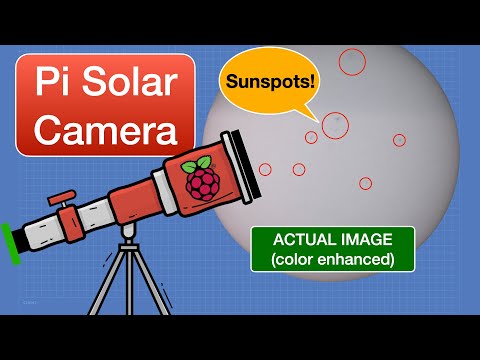
I’ve been following the YouTube channel DroneBot Workshop pretty much since it first started up eight years ago. For DIY electronics geeks, it’s a treasure trove of wonderful information. So, I was pleased to see a photo-related video pop up.
In this video, Bill – the host of DroneBot Workshop – walks us through his build of a Raspberry Pi Solar Camera. With the eclipse coming up on April 8th, now’s a good time to start preparing!
Raspberry Pi, HQ Camera and a Telescope
It seems like many of the DIY camera projects right now are powered by a Raspberry Pi. Oh, and the Raspberry Pi HQ Camera module. This project is no different, utilising both the Pi and the HQ camera. But there’s a reason for that. They work well together and offer a reasonable level of quality.
The big difference here, however, is that instead of a regular lens, we’re looking through a telescope. Specifically, Bill used a Celestron EclipSmart Solar Scope (buy here), designed specifically for viewing the sun during eclipses.


You don’t have to use this telescope, though. You can use any solar telescope. You can even use a regular telescope if you already have one, but you will still need to add solar filters to it. The benefit of buying a solar telescope is that these filters are built in place and won’t fall out.
So, they’re safer.
A simpler design
Although it looks like quite an intimidating setup, it’s actually quite a simple design. Because it utilises a telescope that’s already equipped for viewing the sun, there are no filters to deal with.
Most solar filters come in sheets that you tape onto the light. These filters can easily become lost or damaged during transit. So, you have to carry spares and tape and make sure to fit it properly each time you shoot.
Of course, you still need to attach the telescope to the HQ camera module. And you need to connect that module to the Pi. And you need to store that Pi somewhere that isn’t in the way of the camera module or the lens.
Don’t forget the software!
As well as going through the entire hardware build, Bill also walks us through the software. In fact, almost as much of the video is dedicated to the software as it is to the hardware. Understanding the software is key to getting decent shots.
Bill shows Astroberry Server, RPi Cam ASCOM Alpaca, and Picamera2 Web UI Lite. I’d probably do a little more research into each of the apps shown in the video. But if you’re serious about this kind of stuff, they look like a good place to start.
As well as going over the entire build, Bill walks us through the software to get it to shoot images of the sky. But he also shows us the software for post-processing the images to get the best results from the Pi HQ camera.
Along with plenty of tips to help you prepare for photographing an eclipse, it’s a great project for budding astrophotographers! And be sure to check out these eclipse photography tips, too!







